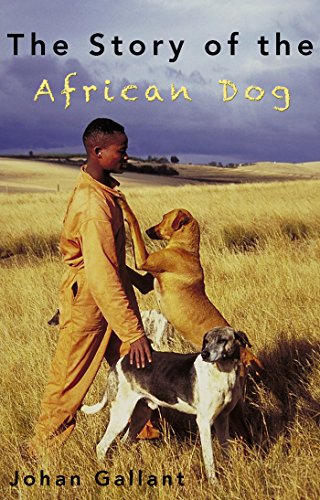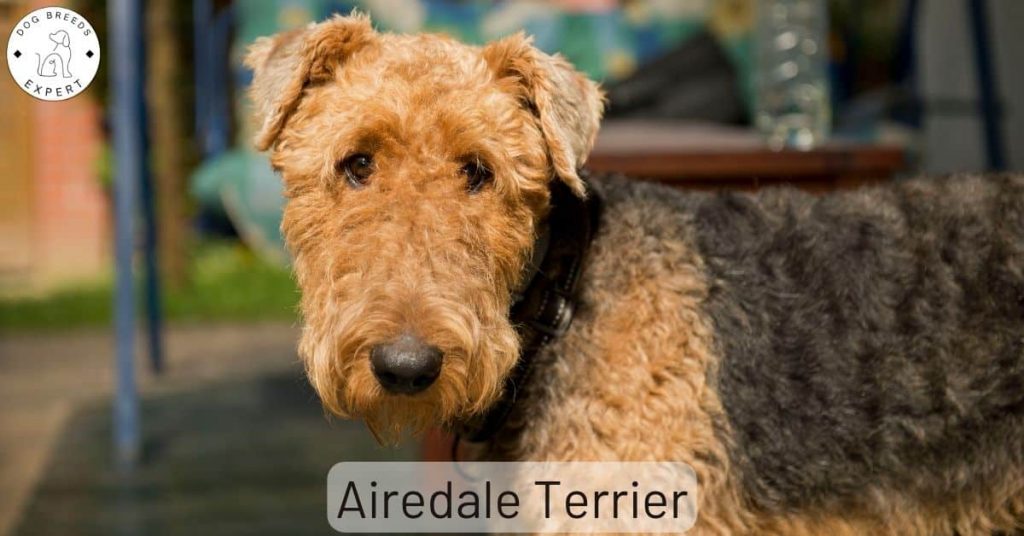The South African Mastiff – Family Friendly or Dangerous Dog?
The African Boerboel, or the South African mastiff as it is also known, is a large, confident dog descended from the mastiffs that first came to Africa in the late 1600s.
Despite their large size, they are playful and affectionate with their family. Powerful, muscular and highly intelligent, they are also considered the most agile of the large mastiff breeds.
Folklore suggests that they were capable of killing a lion, but it is more likely that they could catch and take down a leopard. It would take several dogs to bring down a lion, and that role was already being fulfilled by the Rhodesian Ridgeback.
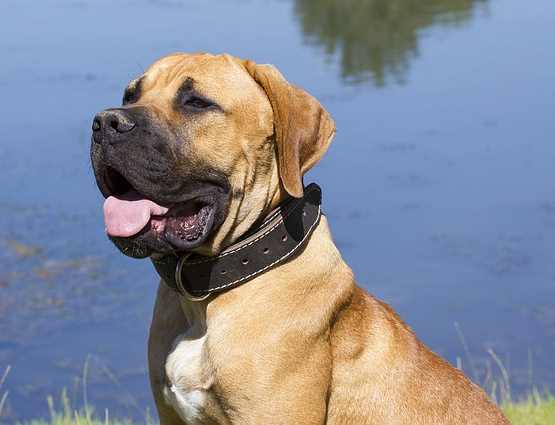
Considered by many people to be protective without being overly aggressive, they make an excellent choice for a family pet because they do exceptionally well with children.
They are totally devoted and happy to be with their owners, but they are wary of strangers, making them a good choice for a guard dog.
So fearless and loyal, they would fight to the death to protect their own family. Visitors and friends that enter the house should be introduced to the dog.
Though gentle and tolerant of anyone within the family, they still require a special type of owner. People interested in this breed must be experienced with large dogs and display a confident, authoritative manner.
These dogs are dominant and can become a real problem if not trained properly. Families must teach their children to be respectful, but at the same time, the dog must always know that even the smallest member of the household is still to be respected.
Children should be supervised when playing with a dog such as the African Boerboel. Even though they are gentle and tolerant of children, these dogs are also massive and can easily knock over a small child or even a vulnerable adult.
As a pet, they do not do well if isolated outdoors. They crave human companionship and without human company they can become depressed and destructive.
They generally do well with other animals including cats, but ongoing socialization and training is necessary. Historically, these dogs were used on farms and for protection.
These traits remain with them and will likely guard any other animals living within what they consider being their domain.
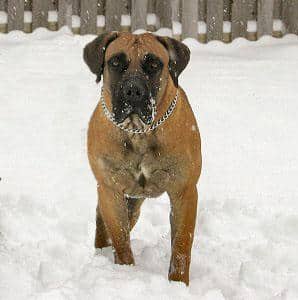
The Boerboel is not a good choice for an apartment lifestyle. They need a decent amount of room to exercise and a home with a fenced in yard is an idea.
While calm and at times lazy, they are also an energetic breed needing a good deal of exercise to keep them fit. They can get some of their exercise needs met with a lively game of fetch, but they also enjoy long walks with their owner.
The Boerboel should always be on the leash when out and about, and owners should be cautious when encountering strangers or strange dogs.
They should not be allowed off leash and unsupervised because of their guarding propensity. They also do not do well at dog parks.
African Boerboel – History
There is no certainty as to the actual breeds that went into the development of the Boerboel. What is known for sure is that Jan van Riebeeck, the founder of the Dutch settlement at the Cape of Good Hope, brought a tough mastiff breed with him.
It was a breed called the Bullenbijter, a now extinct bull baiting breed used for protection. Other settlers brought along other types of mastiffs and hounds.
There are many different Mastiff-types of dogs worldwide and they all originated much earlier in history. Most can trace their roots to Molosser dogs such as those owned and used in ancient Rome.
The breed’s name “boer” comes from the Dutch or Afrikaans word for farmer. Boel is an Old Dutch word for dog, so the name means Farmer’s dog. These dogs were bred with native African dogs especially the Khoi dog which gave the developing breed some protection from local disease and the hot sun.
The British arrived around 1820 with their Mastiffs and Bulldogs. During The Great Trek, the Dutch settlers migrated thousands of miles to the interior of Africa to escape British rule and took with them their dogs. Only the strongest and healthiest of these dogs survived which left a very hardy breeding stock.
The world first learned about the breed through an American anthropologist, Dr. Carl Semencic through his articles in several magazines. In South Africa today, breeding takes place both as a business as well as a hobby. Dogs are exported all over the world.
There are, however, some countries that have banned or prohibited the import of these dogs.
There are some local restrictions in some U.S. states. For example, according to Petolog, France, Romania, the Bermuda Islands, and Singapore are some of those areas where Boerboel dogs are not permitted to reside.
If you are considering the addition of one of these dogs, be sure to check whether they are legal in your area.
Fanciers of the breed love the calm, stable temperament as well as their obedience and intelligence. In Africa, they are still the most popular breed of farmers and used in more urban areas for the same reason: They instincts to guard and protect.
They were first recognized by the American Kennel Club in 2015 and are listed as 131st in popularity among AKC’s 189 breeds.
Vital Statistics
Height
Males 25 – 28 inches (64 – 70 cm)
Females 23 – 25.5 inches (59 – 65 cm)
Weight: 154 – 200 pounds (70 – 90 kg)
Life Expectancy: About 10-12 years
Colors
A.K.C. lists six colors:
- Brindle
- Brown
- Cream
- Red
- Reddish brown
- Tawny
Four Markings:
- Black Mask
- Irish mask
- Piebald
- White markings
Standards vary depending on where you are located in the world. Check your country’s standards for acceptable colors.
The skin of a Boerboel is darker on his stomach and the roof of his mouth. This more colored pigment was considered necessary in his country for protection against the sun and heat.
African Boerboel – Grooming
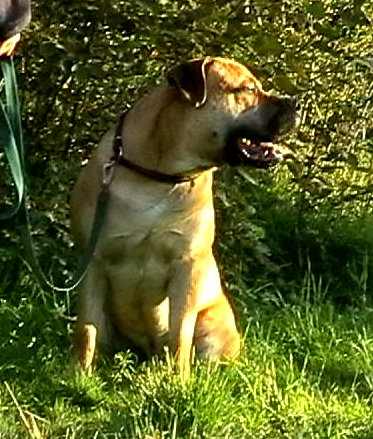
These dogs have a short, dense, smooth coat that is easy to groom. They are an average shedder.
An occasional brushing is recommended and bathing can be done when necessarily. Brushing should be done with a soft bristle brush or hound glove for best results.
Their nails will require clipping about every 2 to 3 weeks or as needed depending or can be ground down using a nail grinder.
Good dental care is important as well and teeth should regularly be brushed using a canine toothpaste and toothbrush.
Ears should be checked periodically and cleaned using a gentle ear wash solution.
Ears are not cropped but their tails are generally docked at birth in the U.S. Some countries in the world ban the docking of tails.
African Boerboel – Ease of Training

The African Boerboel is an intelligent breed which requires consistent, firm, positive reinforcement. Harsh means of training is not recommended, but rather ongoing training by a dominant owner works best. These dogs do best with owners who have had experience with large, independent breeds in the past.
The muscular strength, size, and athletic ability, plus their capability of being intensely ferocious makes these dogs extremely dangerous in the hands of inexperienced or irresponsible owners. They are not the breed for everyone.
Early and consistent socialization is important for any dog, but especially for powerful dogs like the Boerboel. When they are introduced to a wide variety of people, animals, things, new scents, sounds and experienced since birth, they will become a much more balanced and stable dog as an adult.
Socialization is not a one-time event, but rather an ongoing process that occurs most intensely in the early months but should extend throughout the lifespan of the dog.
Boerboels can also participate in several doggie sports. Obedience and agility are two sports where they have done very well. Although most Boerboels don’t like people they don’t know, some have become certified as therapy dogs.
Protection
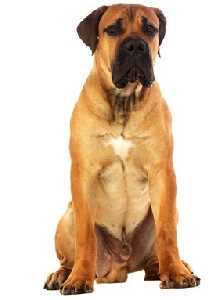
Protection is what these dogs were meant to do and they will protect you to the death. With such a powerful guarding instinct, you really can’t go wrong if that is what you need and want in a dog.
With that said, the owner of these dogs must always be aware that fights can break out fast and even friendly strangers or dogs can be at risk.
If you are considering getting two of these dogs, it is usually recommended that you get one of each gender. If dog fights are going to break out, same sex dogs usually fight each other.
African Boerboel – Health Considerations
These dogs enjoy a relatively healthy existence. However, like all people and dogs, they are prone to certain genetic diseases. Even though they are listed here, the chance that your dog will be plagued with any is not a certainty.
Good breeders will be able to test their adults for many of these problems and will not breed dogs that have health issues. Some of the more common health problems that have been reported in this breed include the following.
Reputable breeds can have their breed stock x-rayed for Hip and Elbow Dysplasia and their eyes checked by a veterinary ophthalmologist.
Bloat is reported in many large and giant breed dogs. Encouraging the dog to eat slower through the use of special bowls helps. Preventing exercise after eating for about an hour also helps avoid this condition.
- Hip Dysplasia
- Elbow Dysplasia
- Ectropion
- Gastric Dilation and Volvulus (Bloat)
This video tells the story of the Boerboel’s personality, done in photos.
Story of the African Dog
We have found this amazing book, The Story of the African Dog, telling the history of the African Dog from its earliest presence at the fire of Stone Age humans, through the evolution from wolf to protodog to domestic dog and subsequent migration into the African continent with nomadic Neolithic herders. You can read more about this really interesting book and buy online at Amazon here.
